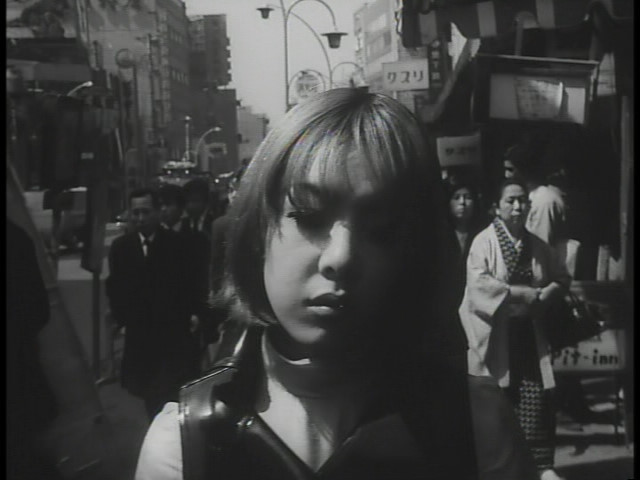 This film was screened as part of the 1968 season, which is running between April-June in a series of London venues and not just incorporating film but other art forms. During the 1960s and as in Western Europe, a new wave of Japanese cinema emerged, which broke with the classical film making tradition as exemplified by the likes of Kurosawa, Mizoguchi and Ozu. Young film makers like Teshigahara and Oshima appeared on the scene and themes such as youth, sexuality and protagonists as outsiders on the fringes of society were explored with increasing frequency. One of the finest examples of these themes being addressed simultaneously, against the backdrop of revolution in the Western world, was 'Funeral Parade of Roses'.
This film was screened as part of the 1968 season, which is running between April-June in a series of London venues and not just incorporating film but other art forms. During the 1960s and as in Western Europe, a new wave of Japanese cinema emerged, which broke with the classical film making tradition as exemplified by the likes of Kurosawa, Mizoguchi and Ozu. Young film makers like Teshigahara and Oshima appeared on the scene and themes such as youth, sexuality and protagonists as outsiders on the fringes of society were explored with increasing frequency. One of the finest examples of these themes being addressed simultaneously, against the backdrop of revolution in the Western world, was 'Funeral Parade of Roses'.On one level, this film inverts the Oedipus myth, giving in a distinctly homosexual twist. Eddie (Peter) is a young cross-dressing male involved in an affair with his boss but haunted by recurring memories of having murdered his mother in flagrante with another man, as well as the absence of his father who is represented by a photograph in which his face is burned through by a cigarette. Eddie is representative of a young subculture in Tokyo; that of drag queens - men who have chosen to live as women but are not transsexuals. Eddie's rival for their boss's attentions is Leda, who sets herself up as Eddie's opposite. Where Eddie is always rude, late and flirtatious, Leda almost believes herself to be a traditional geisha with refined manners and behavioral codes.
Matsumoto's roots were in documentaries and this is very much evident here. There are many "interviews" with the drag queens themselves, with questions about why they've chosen to live this way, whether they like men or women etc, and often the narrative blurs that distinction between what part of the film and what is part of a documentary in itself. Eddie is making love to an American GI she met at the bar (Genet) she works at and then suddenly we cut to them being filmed by a documentary film maker. And then there is the political element with uses of other media. Student riots in Japan are shown on television, which are also filmed from the television. This puts the film in a degree of context for the era. There had been protests regarding the use of Japanese air bases by the Americans and also security treaties between the two countries. Although this film is not ostensibly about these issues, they're hard to ignore within the film.
Matsumoto shows himself to be a remarkably astute visual artist. There are many memorable visual gimmicks in this film which proved to be influential in years to come. Much has been made of the influence this film has on Kubrick's 'A Clockwork Orange', most notably the fast motion scenes with electronically treated classical music used when Eddie and two friends have a street fight with three girls (just after eating the sexually suggestive ice creams that also feature in the record shop scene in 'A Clockwork Orange') and also a catfight between Eddie and Leda. The latter scene is also memorable for starting almost as a comic strip with the insults represented as speech bubbles. It's a stunning numbers of ways of rewriting the language of cinema and the influence of these visual tricks lives on, which is especially fascinating since this is such a little viewed film.
As it must, the climax reflects that of the myth itself and is suitably shocking and violent (to re-emphasis the myth as the basis for the film, Eddie at one stage stands in front of a poster for the Pasolini film of Oedipus Rex) as Eddie wanders blinded amongst a crowd of bystanders who reportedly had no idea they were being filmed. Having committed suicide, Leda poked two pins through the eyes of the voodoo doll supposed to represent Eddie, which also reinforces the fact that these events are pre-ordained by fate.
Matsumoto only made four features but has a wealth of documentaries and shorts available. 'Funeral Parade of Roses' is a stunning example of blending both schools of film making, whilst incorporating a number of contemporary themes effortlessly. 4.5/5
No comments:
Post a Comment